Museums
A sneak peek at great art
September 28, 2010
LACMA’s new Lynda and Stewart Resnick Exhibition Pavilion opens to the public this week. The three inaugural exhibits range from ancient to modern, colossal stone carvings to intricate beaded dresses. Images from a recent press preview for the 45,000 square foot gallery space, designed by Renzo Piano, capture the wide range of art under one expansively sky-lit roof.
Tickets for this weekend’s community weekend are free, but they are going fast. Check out LACMA’s website on Thursday to secure last minute tickets—or become a museum member and go anytime.
Posted 9-28-10
A head of their time
September 21, 2010
Before L.A.’s cultural bigshots can walk down the red carpet for the gala opening of LACMA’s new Resnick Pavilion, some real heavyweights had to make their own grand entrances.
The big men are a pair of Mexican kings, giant basalt heads of long-dead rulers of an ancient Mexican civilization that flourished more than 3,000 years ago.
They are the stars of “Olmec: Colossal Masterworks of Ancient Mexico,” one of three inaugural exhibitions that will launch the new Lynda and Stewart Resnick Exhibition Pavilion at LACMA, which opens to the public on October 2 after festivities that include a grand gala opening.
Grand ceremony wouldn’t faze the two Olmec kings, whose names are lost to history but whose unforgettable heads weigh between 4 and 5 tons. The larger of the two depicts a ruler with a stern and masterful face. The other wears a sly half smile.
“These are individuals, and they are meant to be massive portraits,” said Virginia Fields, a co-curator of the show and LACMA’s senior curator of the arts of the Ancient Americas. The pair came from the ancient Olmec city of San Lorenzo Tenochtitlan, near modern Veracruz.
The kings’ elaborate royal progress from Mexico to LACMA was fit for a monarch. Wrapped in cloth and packed in padded wooden crates, the heads were air freighted north. Upon arrival at the Resnick Pavilion, they were met by work crews who gently unpacked them and strapped them to gantries and pulleys.
“I kept thinking, ‘How would the Olmecs have done this?’” Fields thought as she watched work crews carefully steering the giant heads to their resting places.
Then they were gently lowered onto a pair of monumental oxidized steel platforms designed by American sculptor Michael Heizer. Heizer, coincidentally, learned about the Olmecs as a boy. (His father was a UC Berkeley archeologist who studied Olmec culture.)
Joining the kings are about 120 other works large and small, including bowls, axes, pottery and sculpture. Among the large pieces: a pair of seated “twins,” who were priests or rulers, dressed alike in elaborate turbans. A large and mysterious woman standing at the mouth of a cave is the only large female figure ever found in Olmec art, said Fields.
In addition to the Olmec exhibit, two other shows will launch the Resnick, a striking gallery by Italian architect Renzo Piano, who also designed the neighboring Broad Contemporary Art Museum at LACMA.
“Eye for the Sensual: Selections from the Resnick Collection” showcases highlights of the family’s collection of European and American paintings, sculpture and decorative arts from the 16th to 20th century, including Art Deco masterpieces and an iconic portrait of Queen Marie-Antoinette.
“Fashioning Fashion: European Dress in Detail, 1700-1915,” is a kaleidoscopic display of the evolution of fashion styles and techniques featuring 250 gowns, dresses and suits.
The world premiere of all three exhibits—and of the building itself—comes Saturday night, September 25, with an invitation-only fundraising gala featuring a performance by Christina Aguilera. The dinner will honor the Resnicks, L.A. area business owners and philanthropists who gave $45 million to build the museum.
On the 28th, the museum hosts community partners for another preview.
The building will be thrown open to the general public with a free community weekend October 2-3 that will feature Latin music and storytelling as well as admission to the entire museum. The free entry does require tickets, which can be reserved now by calling (323) 857-6010 or visiting LACMA’s website.
Posted 9/21/10
A Grand location for Broad Museum
August 23, 2010
It’s official: Eli Broad absolutely will be building his namesake contemporary art museum along a stretch of Downtown Los Angeles with aspirations as audacious as its name—Grand Avenue.
“We want to make great works of contemporary art accessible to the broadest public, and we can think of no better location than in the center of the contemporary art world,” the billionaire philanthropist said in a media statement Monday, following the last in a series of approvals for the museum and parking lot. The Broad’s are expected to spend between $80 and $100 million on the project.
The museum, which will house the legendary contemporary collection of Broad and his wife, Edythe, is expected to be completed by late 2012.
Broad also announced that the museum—located near Walt Disney Concert Hall and the Museum of Contemporary Art—would be designed by the architectural firm of Diller, Scofidio + Renfro, which, among its many civic projects, designed the new Institute of Contemporary Art on Boston harbor as well as the renovation and expansion of Lincoln Center in New York.
Talking to reporters, Broad said the New York firm’s work would complement, “not clash,” with architect Frank Gehry’s iconic Disney Hall—but added that it also would not be “anonymous.” The design will be made public, Broad said, in October, when construction on the parking lot is expected to begin.
Broad’s long-awaited announcement came after the Grand Avenue Authority, a multi-agency panel that oversees the project, unanimously approved construction of the museum, which came into play only after a plan for retail businesses and residences was undermined by the deteriorating economy.
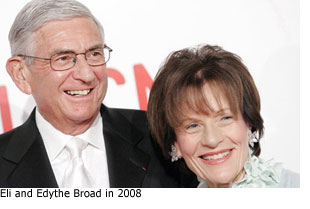 The hope of all involved is that the infusion of money into the Broad Collection museum—and the tourism it will encourage—will persuade other investors to get off the sidelines and rejoin the project.
The hope of all involved is that the infusion of money into the Broad Collection museum—and the tourism it will encourage—will persuade other investors to get off the sidelines and rejoin the project.
Los Angeles City Councilwoman Jan Perry, a member of the authority, called the Broad museum “a tremendous Plan B that we hadn’t anticipated,” one that she hopes will “reinvigorate interest” in the larger Grand Avenue plan.
In comments after the joint power authority’s vote, Broad made clear that the downtown site had long been his first and best option for the museum—despite statements from his camp that Santa Monica was in serious contention until the end.
“We always wanted it on Grand Avenue,” Broad said.
Last week, he expressed a similar sentiment to a writer for Supervisor Yaroslavsky’s website after the board signed off on the Grand Avenue location. “Absolutely, it’s coming to this site,” he told the writer.
Broad said he wanted to create a “populist institution” that would draw not only cultural tourists but youngsters from the region as well as the increasing numbers of people who now make downtown Los Angeles their home.
The museum will include approximately 50,000 square feet of sky lit galleries, a lecture hall and public lobby. There will be enough space, Broad said, to display upwards of 300 pieces—mostly from the 1970s, ‘80s, and ‘90s—including pieces from Roy Lichtenstein, Andy Warhol and Cindy Sherman.
As part of Broad’s agreement with Los Angeles County and the Grand Avenue Authority, he has agreed to pay more than $7 million for the construction of affordable housing. The Broads also will endow the Broad Art Foundation with $200 million to cover the museum’s ongoing annual operating expenses.
Posted 8/23/10
Broad museum headed downtown [updated]
August 17, 2010
The legendary art collection of Eli and Edythe Broad is one step closer to finding a permanent home—in a new “world class” museum to be built at 2nd Street and Grand Avenue in downtown Los Angeles.
County supervisors on Tuesday signed off on a revised plan to build the contemporary art museum on the site, which originally had been targeted for retail uses under the Grand Avenue Project. When that project originally was approved in 2007, developers had envisioned a sweeping array of businesses, residences, cultural attractions and a hotel along the corridor. Most of those elements are now on hold because of the recession, although one of the project’s centerpieces, a Civic Park stretching from the Music Center to City Hall, recently broke ground.
The supervisors’ sign-off on the new museum means that only one more official approval is required for the plan. That’s expected to come Monday from the joint powers authority overseeing the Grand Avenue Project.
Eli Broad was in the audience at the Hall of Administration on Tuesday, and said after the vote that the museum was headed downtown—not to Santa Monica, which also had been in contention.
“Absolutely it’s coming to this site,” Broad said.
But he declined to name the project’s architect, who is expected to be named on Monday. Architects including Rem Koolhaas and Diller Scofidio + Renfro have been reported as contenders for the commission.
Broad is picking up the $80 million to $100 million tab to build the museum and will set up a $200 million endowment to run it. Under the plan approved Tuesday, Broad also will be paying an additional $7.7 million that the county treasurer will hold in trust to build affordable housing downtown.
A museum to house the Broads’ collection—whose works are frequently loaned to other institutions for public display—is seen by cultural and business leaders as a vital step in downtown’s renaissance.
David Johnson, co-chair of MOCA’s board of trustees, said that the new museum across the street will “make Los Angeles one of the most important places in the world to see contemporary art.”
Carol Schatz, president and CEO of the Central City Association, said it will create 1,500 jobs and provide $234 million annually in related economic benefits.
“Cultural tourism is one of the great multipliers,” she noted.
Stephen Rountree, president and CEO of the Music Center, said he welcomes the energy the new museum will bring to the neighborhood—along with younger audiences he hopes will stick around to sample the offerings of his resident companies.
Broad, who did not address the board, echoed those hopes after the meeting:
“The exciting part is we want to dramatically increase attendance to all of the cultural organizations on Grand Avenue,” he said.
He noted that the new museum, with its architect to be named Monday, will join a spectacular stretch of buildings: Coop Himmelblau’s High School for the Visual and Performing Arts, Jose Rafael Moneo’s Cathedral of Our Lady of the Angels, the Frank Gehry-designed Walt Disney Concert Hall and MOCA, designed by Arata Isozaki.
The new 115,000-to-120,000-square-foot museum is to be built on three levels. Its galleries will display pieces from the Broads’ collection of more than 2,000 works by artists including Andy Warhol, Roy Lichtenstein, Damien Hirst, Cindy Sherman and Jeff Koons.
Posted 8/17/10
Updated 8/18/10: Following Broad’s reported comments on Supervisor Yaroslavsky’s website that the museum “absolutely” will be built in Downtown Los Angeles, a spokeswoman for the Broad Foundation, Karen Denne, said Wednesday that “no decision has or will be made” until after the upcoming meeting of the Joint Powers Authority. She said Broad did not make the statement, which is documented in the writer’s notes from her interview with Broad on Tuesday at the county Hall of Administration. The supervisor’s website stands behind its report.
Stitches in time for grand old gowns
July 29, 2010
There’s nothing like the prospect of a glamorous Los Angeles debut to make even the most luxurious wardrobe cry out for a little freshening up.
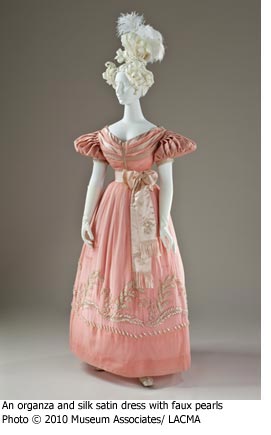 Especially when the clothes are hundreds of years old.
Especially when the clothes are hundreds of years old.
When Catherine McLean, the head of textile conservation at LACMA, got the assignment to prepare about 250 ornate European dresses, gowns, suits and accessories for exhibition, the pressure was on.
Not only would it be a race against the clock to ready the garments for the upcoming “Fashioning Fashion: European Dress in Detail, 1700-1915.” McLean and her team also would have hands-on responsibility for spiffing up one of the museum’s hottest acquisitions in recent years—the multimillion dollar Kamer-Ruf collection, made up of more than 1,000 garments and accessories and named for the two European art dealers who assembled it.
Just landing the collection was a major coup.
“This really is a transformative acquisition,” says LACMA costume and textiles department curator Kaye Spilker, who curated the show with Sharon Takeda, the department head and senior curator. “I would think it puts us into the first tier of museum collections as regards the quality of the objects.”
The deadline wasn’t negotiable, either. The exhibition, which will explore the changing styles and techniques of fashions of the gentry and aristocracy, had to be ready for the October 2 grand opening of the new Renzo Piano-designed Resnick Pavilion.
That meant just two years for McLean and company to accomplish hundreds of tasks: refurbishing, stitching, cleaning and otherwise preparing for their close-ups hundreds of outfits that once were among the most glamorous in the Western world.
Work on the new collection was both inspiring and, occasionally, a source of “sheer terror” for McLean.
“We were pretty worried we wouldn’t be able to get it all done in time,” says McLean. “[But] the fact that this collection was so amazing was a real motivator. The pieces just light up the whole room.”
Facing the large job was McLean’s small crew. She and associate textiles curator Susan Schmalz are the only permanent staffers. They work with Maria Fusco, funded by a year-long Mellon Fellowship, and summer intern Lynn Bathke. Their base is a studio in LACMA’s Conservation Center, near specialists in paintings, three-dimensional objects, paper and scientific research.
A 30-year LACMA veteran, McLean found her vocation early. She got a volunteer job at a Detroit museum in high school where she enjoyed even the lowly task of removing linings from tapestries. “I was hooked,” she recalls, and after grad school came west to LACMA. She’s worked on modern clothing, pre-Columbian cloth and the museum’s famous Ardabil Carpet, once owned by J. Paul Getty.
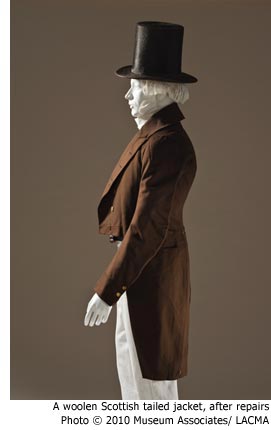 Textile conservation straddles a line between science and art. The conservators must know the chemistry of dyes and cleaning solvents as well as art history and the properties of dozens of fabrics. Deftness and patience are required for all the sewing, weaving and knitting involved.
Textile conservation straddles a line between science and art. The conservators must know the chemistry of dyes and cleaning solvents as well as art history and the properties of dozens of fabrics. Deftness and patience are required for all the sewing, weaving and knitting involved.
“The conservators do very exacting work under a lot of pressure,” says Spilker. “They are very good, and in their work they can’t make a mistake.”
The collection was in excellent condition. But time can damage a 200-year-old dress, no matter how well cared for.
First, they had to kill any potential pests by placing the items in freezers or oxygen-free nitrogen containers. Then they conducted a careful inventory, writing a detailed conditions report for every item in the show. They made the most complicated repairs first, saving the easiest for last.
Some highlights of their labors:
- A pink silk gown, from England, dating to 1830, had rips and tears thanks to its weighty decorations—architectural shoulders stuffed with horse hair and hundreds of faux pearls. Fusco re-stitched old repairs and mended new spots. She replaced the horse hair to repair the shoulders and added new glass pearls, though without using the original method of obtaining iridescent dye from fish scales. “We’re not trying to fool anybody” by exactly matching the originals, says Fusco.
- Silk stockings were a sexy item in 1700, but they tended to run back then, too. Schmalz is still working on repairing runs in a pair of silk knit women’s hose, embroidered with silvery birds and plants. (Curators found a similar stocking depicted in a scene in one of William Hogarth’s “A Rake’s Progress” paintings.) She’s making the repairs using tiny “insect pins,” a crocheting needle and a magnifying lens. “This is my most challenging piece,” says Schmalz, who once, on a free-lance assignment, helped restore an Elvis Presley jumpsuit.
- The team applied new techniques to old problems. A man’s tailed jacket from Scotland, dating from 1845, was pocked with a half dozen moth holes. Normal repairs leave a slight indentation, so Fusco borrowed a technique from home crafters called “needle felting.” Dying loose woolen fleece to the precise shade of brown, she took a square of spare cloth and jabbed the needle quickly up and down until there was a soft brown circle the size of the hole. The result: a near perfect match in color, texture and depth.
- “Fashioning Fashion’s” final piece, a black and gold silk ball gown purportedly worn by Queen Maria II of Portugal in about 1850, started life with a regal 12-foot train. But the train was trimmed in the 1890s, leaving the team struggling to understand how it was originally attached to the dress. So they sewed a piece of new cloth to restore the full length, and then experimented with several methods of pleating to attach the train to the bodice until they got the ideal fit. “Sometimes you have to improvise until it looks right,” says McLean.
After months of tense work juggling color coded charts of “to-do” items, the team is nearly done. By mid-August, mannequins with the clothing will begin to move into the Resnick Pavilion.
McLean is looking forward to viewing the show as a spectator, and says “there’s something magic about an exhibition.”
Even when you know the location of every secret stitch and fix.
Posted 7/29/10
Ancient mammals invade museum
July 8, 2010
Say goodbye to boring field trips and uninspired fossils. Say hello to a brand new cast of prehistoric characters that includes a walking whale, a bone-crushing dog and a “thunder beast” that looks like a cross between a dinosaur and a rhino.
They may be extinct but they sure know how to bring an exhibition to life.
They’re among the stars of the groundbreaking “Age of Mammals” exhibition at the Natural History Museum, which opens July 11 to tell a 65-million year story of mammals—from the fall of dinosaurs to the present day.
The animals have an undeniable cool factor, but the explanations and interactive displays are just as interesting, since they connect the animals to the deeper story of mammal evolution as clearly as, well, your thigh bone’s connected to your hip bone.
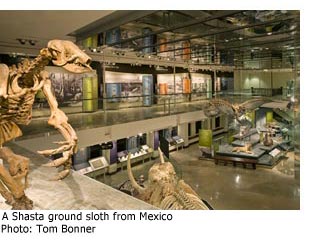 “We’re trying to get to the essence of what a natural history museum should be for a 21st century audience,” says museum president and director Jane Pisano.
“We’re trying to get to the essence of what a natural history museum should be for a 21st century audience,” says museum president and director Jane Pisano.
“Age of Mammals” is the first major permanent exhibition to open as part of an ongoing rebuilding and transformation project leading up to its Centennial in 2013 called “NMH Next.” The project started with the completion last year of a state of the art restoration of the museum’s historic 1913 Building that is finally on display with the opening of the new space. (Read more about the renovation and future exhibits here.)
The new mammals exhibit fills the two-story north wing of the restored building, but the show is housed in a fully modern space lit by a giant skylight and broad rows of windows. Video loops and interactive touch screen displays animate the exhibit.
Virtually all mammals are warm-blooded vertebrates, with hair, who feed their young with milk. But as this show makes clear, the similarities can end there. Here are some of the show’s stars:
- The Simi Valley Mastodon, a 50,000 year old skeleton found in 2001 at a construction dig near the Ronald Reagan Freeway. Nearly nine feet high, it’s the biggest fossil skeleton in the show.
- A giant Paleoparadoxiid, with a head like a hippo and bizarre paddle-like feet, “looks like nothing you’ve ever seen before,” says John Harris, the mammal show’s chief curator and director of the county’s Page Museum. No wonder its name means “ancient mystery.”
- The Brontothere, or “thunder beast,” that looks like a dinosaur-rhino mix and sprouts a large Y-shaped horn on its snout.
- A 52 million-year-old “walking whale” from Pakistan that stands (literally, on four legs) as living proof that whales’ ancestors started on land. The family resemblance isn’t obvious. This denizen of lakes and rivers “looks a bit like an overgrown opossum,” Harris admits.
- The 8 million-year old “bone crushing dog” from Kansas that stalked ancient horses as a member of the largest dog family ever discovered.
Beyond the animals, the exhibit is important for telling the sweeping story of mammal evolution. “What’s unique about this exhibit is that we explain why it happened,” Harris says.
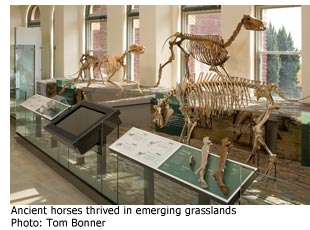 Mammals adapted to global climate changes brought on over millions of years by factors that included the tectonic shift of continents. Or, as a video loop near the mastodon explains: “Continents move, climates change, mammals evolve.”
Mammals adapted to global climate changes brought on over millions of years by factors that included the tectonic shift of continents. Or, as a video loop near the mastodon explains: “Continents move, climates change, mammals evolve.”
An exhibit featuring several ancient horses highlights the rise of swift running grazing animals as warming climates changed forests to grasslands. A display of human evolution shows that grass savannahs were crucial to our development, too.
The displays are full of eye-catching visuals. A pair of cheetahs, a fossil skeleton and a modern stuffed specimen sprint side by side, to show inner and outer views of locomotion. Overhead hang marine fossils including a baby sperm whale, clad in wire mesh to “flesh out” the creatures without obscuring their skeletons.
The exhibition stresses local mammals partly because the collection is rich with them, but also to intrigue visitors who will respond to local sites. as shown in panels on what Los Angeles, Ventura County and the Mojave were like in pre-historic times.
“This is an exhibit for Los Angeles, for Angelenos,” says director of exhibition production Simon Adlam.
Displays on the second floor explain the ideas and techniques that let modern scientists study and understand the ancient world. Near the Paleoparadoxiid, video screens showcase the specimen’s discovery, the excavation and laboratory study.
The exhibit ends with a reminder that humans themselves are now changing the planet’s climate with a threatened polar bear staring from a display case.
“The global warming message is clear, simple and up to date,” says John Long, vice president of research and collections. (A broader climate appeal on the museum’s website can be found here.)
Posted 7/8/2010
Baby, you can’t drive these cars
June 24, 2010
Ah, that old car smell. Step inside the anonymous-looking Gardena warehouse and breathe it in: History. Glamour. Prestige. And a big ol’ steam-powered tractor, complete with dirt-encrusted tires, that Hollywood’s Edgar Bergen drove around his orange grove in the San Fernando Valley.
Stashed away in this unlikely location is one of the country’s most intriguing collections of 75 vintage vehicles, owned by what may seem like an equally unusual collector—the County of Los Angeles.
The county-run Natural History Museum came into possession of the cars when it parted ways with the Petersen Automotive Museum in 2007 as part of a divvy between the two. The Petersen, now a private non-profit institution, kept cars that had been given to its foundation over the years, while the Natural History Museum kept those that had been given to the county by such benefactors as Bergen’s widow, who donated the tractor.
The county collection has been largely off the general public’s radar, although experts and researchers use it heavily and individual cars have been displayed at the Natural History Museum, the Petersen and at other facilities and events.
Now the public is about to get a look. This fall, the museum plans to start offering behind-the-scenes tours one day a month at its Gardena collections facility.
Museum officials also are attempting to refine the collection’s mission—an exercise that includes deciding which vehicles are most important to keep. Their report to the Board of Supervisors is expected by the end of the month.
Will the 1963 Rolls-Royce Silver Cloud III, donated to the county by a Pasadena doctor, make the cut? How about those two rumble seat-equipped Model As? Or the gleaming black 1932 Duesenberg roadster, its imposing body designed at Pasadena’s Walter Murphy coachworks?
Museum officials won’t say which, if any, vehicles may be moving on. But their goal is to focus on vehicles that have a story to tell about Los Angeles and California—especially those that remain in authentic, unrestored condition, with their “cultural DNA intact,” in the words of John Long, the museum’s vice president for research and collections.
“A lot of our cars aren’t wonderfully polished and looking like they’re straight off the showroom floor,” he says.
Some are, of course—like a bright yellow 1927 McFarlan roadster. “It’s totally historically inaccurate, but it’s a gorgeous piece of eye candy,” says the museum’s collections manager, Beth Werling.
The current belle of the garage, however, is an exceptionally rare 1908 Pierce Great Arrow touring car made in Buffalo, N.Y., once owned by the wife of the editor of the San Francisco Examiner. It’s massive and imposing, even regal, with gold monograms on its wine-red doors.
The vehicle is said to be the only one of its kind in original, unrestored condition—something that auto connoisseurs find interesting these days, it turns out.
The Great Arrow’s been invited to participate in the Concours d’Elegance car exhibition in Pebble Beach in August, where Pierce cars will be a particular focus.
“The Concours d’Elegance is the most prestigious car show in the world right now,” Werling says. “Being invited is like being nominated for an Oscar.”
The Concours selection committee is even footing the bill for transporting the car to and from Pebble Beach. “It’s a magnificent car,” says Martin E. Button, who’s on the selection committee and whose company, Cosdel International Transportation, specializes in the import and export of collector cars from around the world.
“It is the only one that is unrestored and in original condition—which is really important…I have a 1909 Pierce Arrow that’s not nearly as rare as this.”
And one of these years—maybe this one—an unrestored car may win big at the Concours.
“We’ve never had an unrestored car win Best of Show, but everybody wants it to happen,” Button says. “We’d love to see that.”
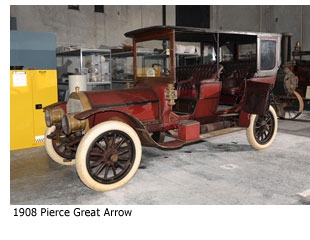 In order to have a shot at rolling over the ramp to a moment of glory in front of the Lodge at Pebble Beach, a car has to actually be drivable, which presents a bit of a problem. The Great Arrow, which was running in 1998 when it previously was exhibited at Pebble Beach as part of the Petersen’s collection, now has a gummed-up carburetor. It’s on its way to a specialty mechanic.
In order to have a shot at rolling over the ramp to a moment of glory in front of the Lodge at Pebble Beach, a car has to actually be drivable, which presents a bit of a problem. The Great Arrow, which was running in 1998 when it previously was exhibited at Pebble Beach as part of the Petersen’s collection, now has a gummed-up carburetor. It’s on its way to a specialty mechanic.
“We’re scrambling to find funding to get it up and running,” Werling says. “We’re not sending it to Pep Boys.”
Werling, who has degrees from Stanford and NYU, also manages Natural History Museum collections ranging from jewelry (“We have Pio Pico’s rosary”) to aircraft (“We have a glider and we have a bi-plane.”) Her previous professional experience with vehicles was limited to tractors at an agricultural museum in Arkansas.
“It’s been a big new world,” she says. “It’s a very complex artifact to take care of.”
As she moves through the collection, Werling points out two types of cars with California links. For some, the connection is obvious—they were made here during the city’s early 20th century burst of automotive entrepreneurial spirit. In this category are the two 1902 Tourists, for example, made by downtown L.A.’s once dominant Auto Vehicle Company.
Then there’s the second category—cars made elsewhere but that reflect something about the California people who made or used them.
Take, for example, the butter yellow 1953 Cadillac Eldorado, to be displayed as part of the museum’s multifaceted Southern California history exhibit “Under the Sun” when it debuts in 2012. The car’s design is the work of the legendary Harley Earl, who was born and raised in Hollywood and went on to fame as head of General Motors’ style department. He got his start in his father’s Earl Automotive Works in Los Angeles, going on to create showy vehicles for Silent Era film stars before Detroit lured him away.
Like the Cadillac, other vehicles have ties to an earlier Los Angeles, a time when local road races became fodder for the era’s moviemakers. The museum’s 1915 Stutz White Squadron Race Car (currently on loan to the Petersen) appeared in an early movie in which a real racecar driver, Earl Cooper, played the love interest to Mabel Normand.
A Jaguar 1954 XK-120 coupe in the collection speaks to Los Angeles’ emergence as a sports car capitol after World War II. “We had the roads that you could drive them on,” Werling says. Those images reached the rest of the country—and the world—by way of Hollywood movies. And the rest, as they say, is history.
When it comes to the stories behind the cars, it’s hard to beat the jaunty red1904 Franklin that staged one of the first cross-county road trips—with Pasadena mechanic Lester Whitman at the wheel—and later survived the San Francisco earthquake. After the quake, as fires raged, the plucky vehicle helped ferry survivors across the bay to Oakland, losing its wicker basket trunk to burning embers in the process.
Now it’s time to present those stories—and the collection as a whole—to the public.
“They’ve got some great cars down there, they really do,” says Button, of the Pebble Beach Concours d’Elegance selection committee. “You have some wonderful cars and I think they’re a real attraction. I just think it’s a real shame to have cars stashed away.”
Focusing on “preservation cars” like the Pierce Great Arrow might be a good niche to develop as the museum refines its collection. “There are no museums that do that,” Button says. “One of the sayings we have, and you can quote it, is: You can’t restore originality.”
By the way, don’t expect any cross-town rivalry from Leslie Kendall, curator of the Petersen Automotive Museum, who says he’d welcome the opening of the Natural History Museum’s collection to the public for tours.
“I can’t get enough,” Kendall says. “I love the idea that there’d be another place I could see great cars.”
Photos by Scott Harms/Los Angeles County
Posted 6/24/10
A neon jungle cruise through downtown L.A.
June 23, 2010
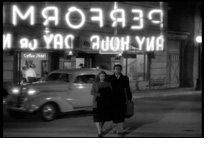 Starting Saturday, June 26, and continuing weekly thereafter through mid-November, the Museum of Neon Art’s award-winning summertime tradition returns with Neon Cruise 2010.
Starting Saturday, June 26, and continuing weekly thereafter through mid-November, the Museum of Neon Art’s award-winning summertime tradition returns with Neon Cruise 2010.
The revels begin at 7:30 p.m. with a wine-and-cheese reception at MONA, located downtown at 136 W. 4th St., between Main and Spring streets. Once urban explorers have sampled the drinks – and the displays – the adventure continues at 8:00 p.m. with a guided British double-decker bus tour by urban anthropologist Eric Lynxwiler, featuring the finest in neon displays from the Broadway Theatre District through Chinatown and Hollywood, concluding downtown where it all began by 11:00 p.m.
Neon signs have decorated the sets of thousands of films and TV programs over the decades, instantly establishing a moody atmosphere of seediness and despair for countless cop shows and murder mysteries. But neon is much than a backdrop, and for nearly 30 years, MONA has dedicated itself to showcasing the finest in neon sculpture and signage, preserving the old and curating showings of the new.
Tickets for the 2010 Neon Cruise are $45 for members and $55 for nonmembers; for further information, call (213) 489-9991. But whether you’re along for the ride or just dropping by for a visit, the experience will shed a little light on this overlooked and underappreciated 20th century art form. To get there, the Metro Trip Planner offers handy public transit options, or you can use these driving directions.
Posted 6/23/10
At LACMA, a new gallery stirs to life
May 26, 2010
The fences are coming down and the invitations are going out—clear signs that a new era in the “transformation” of the Los Angeles County Museum of Art is just months away.
Workers can now be seen putting the final touches on the new Lynda and Stewart Resnick Exhibition Pavilion, a striking 45,000 square-foot gallery by Italian architect Renzo Piano, who also designed the neighboring Broad Contemporary Art Museum.
Meanwhile, 3,000 elaborate invitations featuring a small, silvery Venetian mask with feathers began arriving this week for a gala fundraiser on September 25 to celebrate the Resnick gallery’s “unmasking.”
Guests, who’ll pay from $2,500 a ticket to $100,000 per table to help fund LACMA’s special exhibitions, will be the first to tour the building and its three inaugural exhibits, which include highlights from the Resnicks’ collection and displays of ancient Mexican sculpture and European fashion from 1700 to 1915.
The gallery is scheduled to open to the general public on October 2.
The new gallery was built thanks to a $45 million gift made by the Resnicks in 2008.
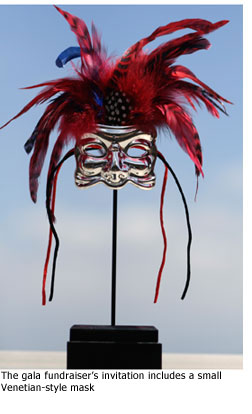 Stewart Resnick is CEO of the Roll Corporation, an L.A.-based holding company that owns extensive tree farms and companies that include Teleflora, Fiji Water and POM Wonderful. Lynda Resnick, the marketing guru behind POM’s iconic curvy bottles, has served as a LACMA trustee since 1992. She designed and donated the unusual invitations for the gallery that carries her name.
Stewart Resnick is CEO of the Roll Corporation, an L.A.-based holding company that owns extensive tree farms and companies that include Teleflora, Fiji Water and POM Wonderful. Lynda Resnick, the marketing guru behind POM’s iconic curvy bottles, has served as a LACMA trustee since 1992. She designed and donated the unusual invitations for the gallery that carries her name.
Initially, the Resnicks were going to donate $25 million for a new grand entrance to LACMA. But when the oil company, BP, offered to fund the entrance, the Resnicks said they’d donate nearly twice as much for construction of the new exhibition hall. The couple also pledged to donate $10 million for art.
The architect, Piano, designed the expansive one-story gallery as a complement to his earlier LACMA work directly to the south, the three-story Broad, which opened in 2008.
The similarities between the two buildings are obvious—travertine-clad walls topped by a skylight-covered roof topped with iconic “fins.” Taken together, the two buildings help create a more unified look on a campus where, until now, each building has differed dramatically from its neighbors.
“You can start to see with the Resnick Pavilion almost complete that the idea was not really to make a building but to make a place,” Piano told a sold-out audience at a “director’s series” conversation with LACMA Director Michael Govan in late April.
The exteriors of both buildings also contain dramatic accents of “Renzo Red,” a signature bright scarlet that the Italian favors. At the Broad, he uses red for the exterior stair cases and escalators. At the Resnick, he uses it on the heating and air conditioning systems, which are visible on the building’s exterior, only recently coming into full view when fencing was removed.
With those fences down, visitors also can now see more of artist Robert Irwin’s “Palm Garden,” the last stage of which is near the Resnick Pavilion. Irwin, who also designed the Getty Center’s garden, began his work at LACMA in 2008 with landscape architect Paul Comstock. Some of the palms are planted in rows, while others are set individually in oxidized steel planters. Between them are lush green lawns.
Already, the garden is exerting a strong pull on visitors.
“It’s such an inviting space,” Eryn Talevich, who was leading a toddler art class at LACMA on a recent Sunday, noted admiringly. “It makes you want to lie down and enjoy the sun.”
For an early review by Los Angeles Times architecture critic Christopher Hawthorne, click here.
Posted 5/26/10




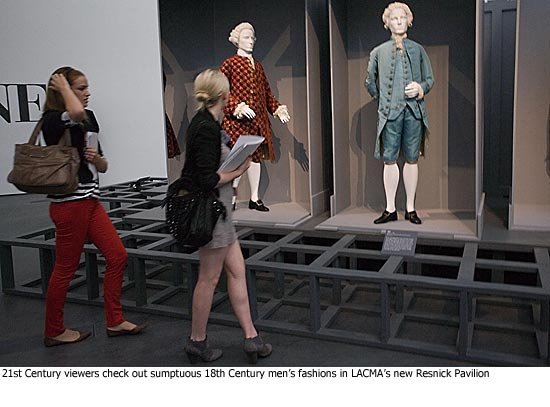










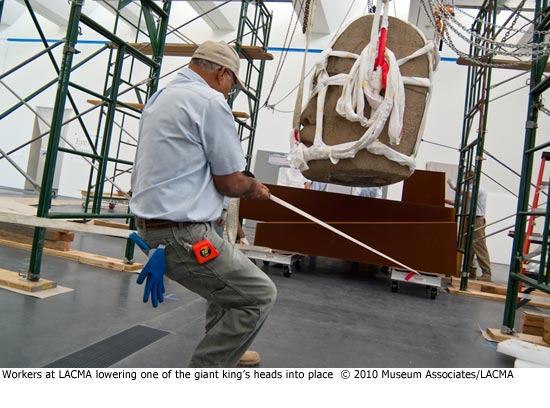





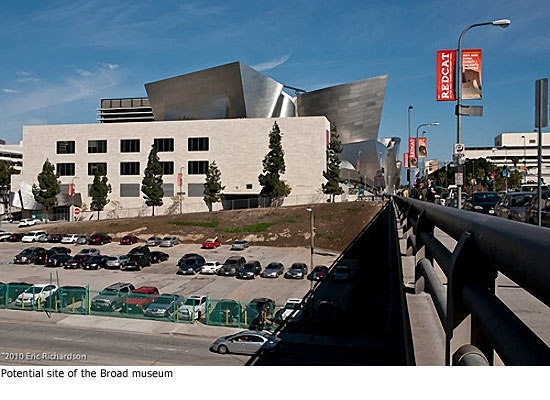

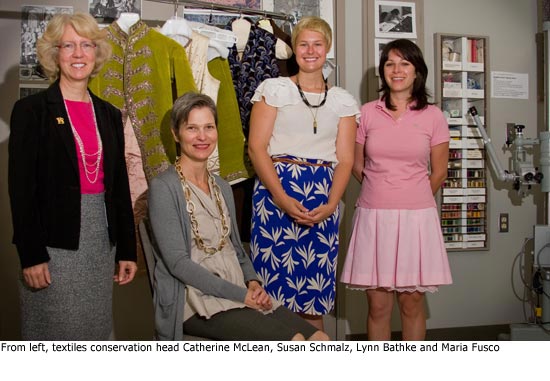





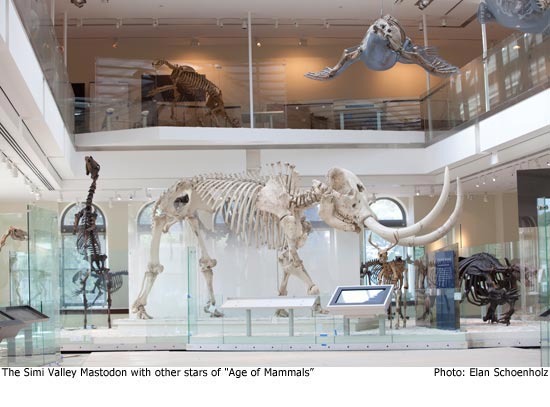
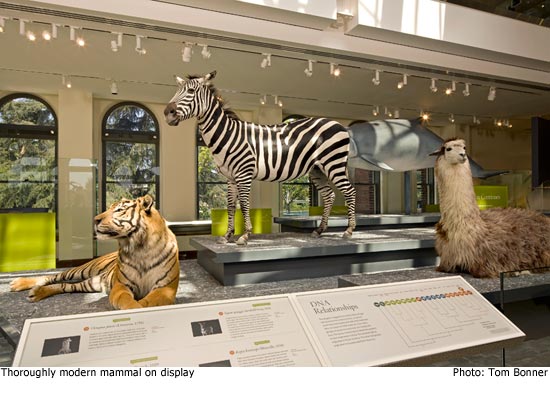
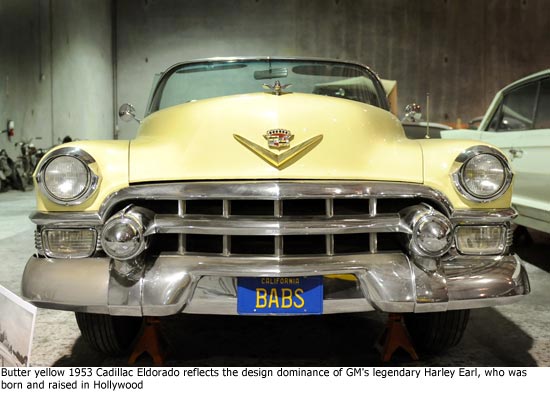
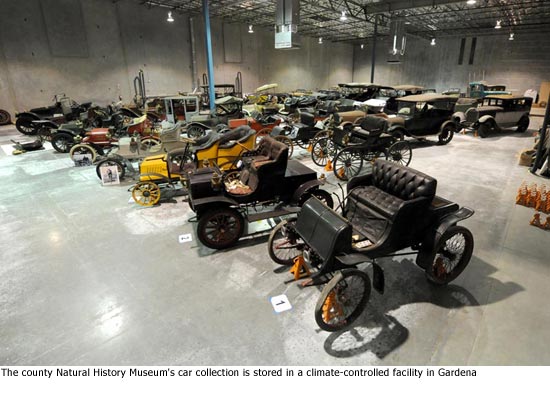















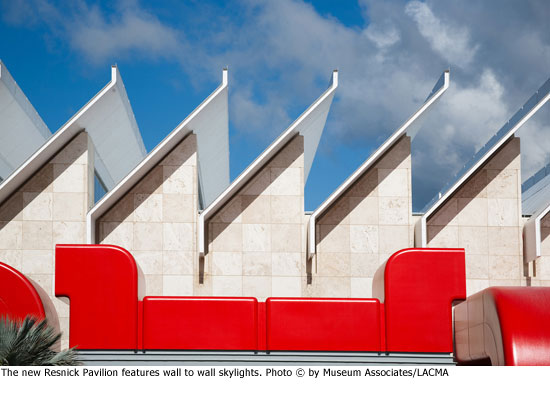
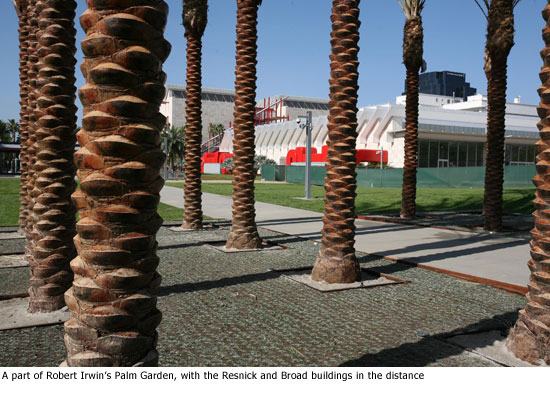









 405 bridge work causes a stink
405 bridge work causes a stink